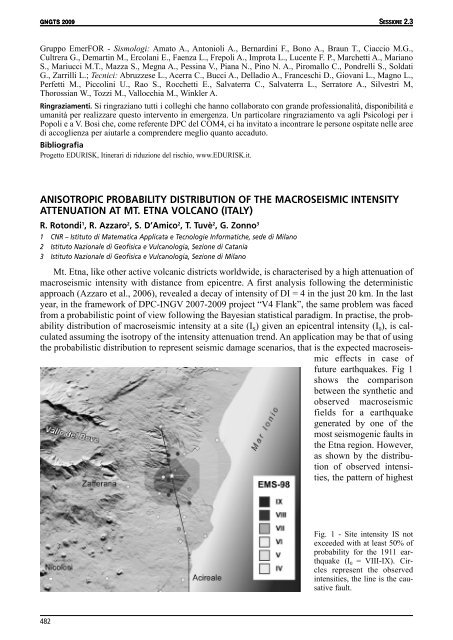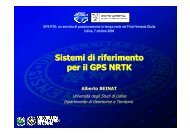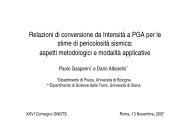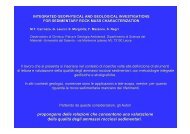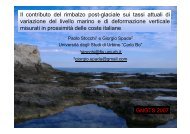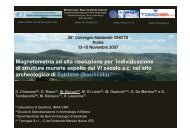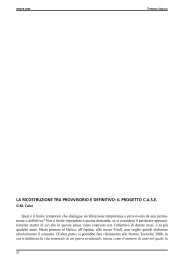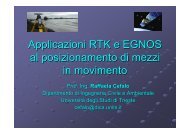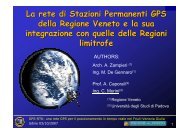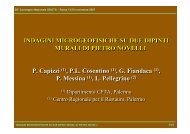Create successful ePaper yourself
Turn your PDF publications into a flip-book with our unique Google optimized e-Paper software.
GNGTS 2009 SESSIONE <strong>2.3</strong><br />
Gruppo EmerFOR - Sismologi: Amato A., Antonioli A., Bernardini F., Bono A., Braun T., Ciaccio M.G.,<br />
Cultrera G., Demartin M., Ercolani E., Faenza L., Frepoli A., Improta L., Lucente F. P., Marchetti A., Mariano<br />
S., Mariucci M.T., Mazza S., Megna A., Pessina V., Piana N., Pino N. A., Piromallo C., Pondrelli S., Soldati<br />
G., Zarrilli L.; Tecnici: Abruzzese L., Acerra C., Bucci A., Delladio A., Franceschi D., Giovani L., Magno L.,<br />
Perfetti M., Piccolini U., Rao S., Rocchetti E., Salvaterra C., Salvaterra L., Serratore A., Silvestri M,<br />
Thorossian W., Tozzi M., Vallocchia M., Winkler A.<br />
Ringraziamenti. Si ringraziano tutti i colleghi che hanno collaborato con grande professionalità, disponibilità e<br />
umanità per realizzare questo intervento in emergenza. Un particolare ringraziamento va agli Psicologi per i<br />
Popoli e a V. Bosi che, come referente DPC del COM4, ci ha invitato a incontrare le persone ospitate nelle aree<br />
di accoglienza per aiutarle a comprendere meglio quanto accaduto.<br />
Bibliografia<br />
Progetto EDURISK, Itinerari di riduzione del rischio, www.EDURISK.it.<br />
ANISOTROPIC PROBABILITY DISTRIBUTION OF THE MACROSEISMIC INTENSITY<br />
ATTENUATION AT MT. ETNA VOLCANO (ITALY)<br />
R. Rotondi 1 , R. Azzaro 2 , S. D’Amico 2 , T. Tuvè 2 , G. Zonno 3<br />
1 CNR – Istituto di Matematica Applicata e Tecnologie Informatiche, sede di Milano<br />
2 Istituto Nazionale di Geofisica e Vulcanologia, Sezione di Catania<br />
3 Istituto Nazionale di Geofisica e Vulcanologia, Sezione di Milano<br />
Mt. Etna, like other active volcanic districts worldwide, is characterised by a high attenuation of<br />
macroseismic intensity with distance from epicentre. A first analysis following the deterministic<br />
approach (Azzaro et al., 2006), revealed a decay of intensity of DI = 4 in the just 20 km. In the last<br />
year, in the framework of DPC-INGV 2007-2009 project “V4 Flank”, the same problem was faced<br />
from a probabilistic point of view following the Bayesian statistical paradigm. In practise, the probability<br />
distribution of macroseismic intensity at a site (I S ) given an epicentral intensity (I 0 ), is calculated<br />
assuming the isotropy of the intensity attenuation trend. An application may be that of using<br />
the probabilistic distribution to represent seismic damage scenarios, that is the expected macroseismic<br />
effects in case of<br />
future earthquakes. Fig 1<br />
shows the comparison<br />
between the synthetic and<br />
observed macroseismic<br />
fields for a earthquake<br />
generated by one of the<br />
most seismogenic faults in<br />
the Etna region. However,<br />
as shown by the distribution<br />
of observed intensities,<br />
the pattern of highest<br />
Fig. 1 - Site intensity IS not<br />
exceeded with at least 50% of<br />
probability for the 1911 earthquake<br />
(I 0 = VIII-IX). Circles<br />
represent the observed<br />
intensities, the line is the causative<br />
fault.<br />
482


